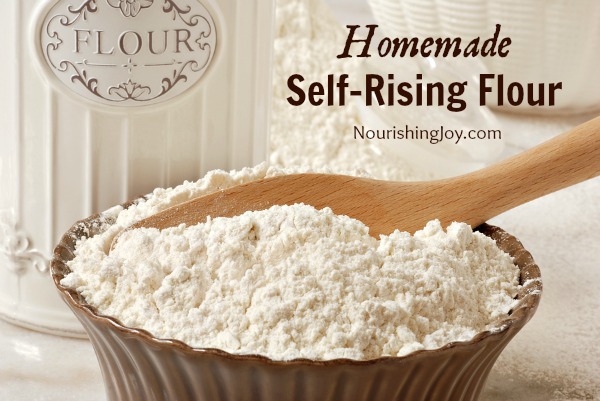Homemade Self-Rising Flour
This post may contain affiliate links, including those from Amazon.com, which means we earn a small commission off your purchases. And here's the thing: We only mention services and products that we think are truly worth your attention, whether they're free, paid, or otherwise. This site relies on YOUR trust, so if we don't stand behind a product 110%, it's not mentioned. Period.
Okay, this is by no means a life-changing post, but since I enjoy reverse engineering store-bought foods and “healthifying” other family favorite recipes, self-rising flour is one of those that I regularly find myself trying to remember how to substitute.
So, I figured I would write it down so I could find it – and why not share it with you all in the process?
If you want to go all-out, you can also make your own baking powder, the recipe for which is in my upcoming cookbook, The DIY Pantry. It's a very simple recipe, but no, I've never purchased grapes from a winemaker to make my own cream of tartar – that exceeds even MY desire to make everything from scratch!
Homemade Self-Rising Flour
Per 1 cup of self-rising flour, mix together:
1 cup all-purpose flour
1 1/2 teaspoons baking powder
1/2 teaspoon sea salt (or other mineral-rich salt)
Whisk or sift together well and store in a cool, dry place for up to six months.
For a larger quantity, it's easy to scale. However, a word of caution: when you're dealing with large amounts of flour and measuring by volume, it's easy to end up with different amounts each time you make the recipe. Thus, I recommend you make large quantities of this recipe by weight instead of volume to ensure consistent results.
To do this, weigh your flour the first time you make this recipe, then merely use that weight every time thereafter. The all-purpose flour I use weighs 145 grams per cup, so I've developed this scaled recipe from that measurement.
10 cups (1.45 kg) all-purpose flour
a scant 1/3 cup (75 g) baking powder
5 teaspoons (25 g) sea-salt
Homemade Self-Rising Flour Alternatives
So, those of you who are regular readers of this site know that I very rarely use all-purpose flour if I can help it, and if I do, it's in sourdough where it can be properly prepared for good digestion, or in a reverse-engineered recipe where I've chosen that the final texture is more important than the health benefits of the recipe.
Thus, there are times when I don't want a self-rising flour that's based on all-purpose flour. Then, I usually use spelt or whole-wheat in place of all-purpose, which works beautifully for things like chocolate cake, pancakes, cookies, and pumpkin bread!
Depending on your type and brand of flour, you may need to add an extra tablespoon or two of liquid, but other than that, I've used this alternative self-rising flour in place of standard self-rising flour cup-for-cup with great success for a number of years.





Its good that you shared this, I’m always surprised that people don’t know what’s in self-raising flour, I was always taught to use one teaspoon of baking powder to each cup of flour. I never buy self-raising because I never know what I will be using flour for, bread, gravy etc doesn’t need raising, so I find just having lots of kinds of flour, as you suggest, and adding raising as required, is more versatile.
That’s an excellent point, Liz! Thanks for pointing that out.
What’s ironic is that while most people in Australia and the deep South (US) know what self-rising flour is, many people in the US and Canada have never heard of it! It’s kind of a regional thing in certain areas…
And off topic – just this minute I was reading your article on starting vegetables from seed – LOVE your sketches on how to lay out a greenhouse and garden! 🙂 http://eight-acres.blogspot.ca/2013/09/tips-for-starting-vegetables-from-seeds.html
I love all you reverse engineering recipes … do you happen to have something for bisquick or other suggestions? It’s one of the few processed items I still keep around due to certain recipes I’ve been making for 25+ years.
Yes, I do actually! I’ll be posting it in a couple of months as a “featured recipe” from my upcoming cookbook, The DIY Pantry, that will be in bookstores everywhere on Jan. 18. 🙂
I know that doesn’t help much NOW, though, so in the meantime, check out Laura’s recipe at Heavenly Homemakers – she’s really lovely!
http://heavenlyhomemakers.com/whole-wheat-quick-baking-mix-sneak-peek-into-our-new-oh-for-real-book